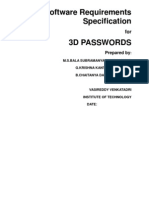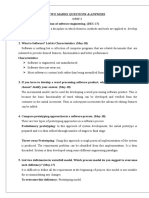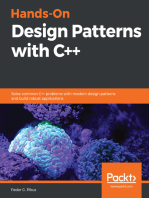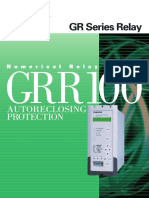Mc9233 Software Engineering
Mc9233 Software Engineering
Uploaded by
novfelnawzinCopyright:
Available Formats
Mc9233 Software Engineering
Mc9233 Software Engineering
Uploaded by
novfelnawzinCopyright
Available Formats
Share this document
Did you find this document useful?
Is this content inappropriate?
Copyright:
Available Formats
Mc9233 Software Engineering
Mc9233 Software Engineering
Uploaded by
novfelnawzinCopyright:
Available Formats
MC9233 UNIT I
SOFTWARE ENGINEERING INTRODUCTION
L T P C 3 0 0 3
Software Engineering paradigms Waterfall Life cycle model Spiral Model Prototype Model fourth Generation Techniques Planning Cost Estimation Organization Structure Software Project Scheduling, Risk analysis and management Requirements and Specification Rapid Prototyping. UNIT II SOFTWARE DESIGN Abstraction Modularity Software Architecture Cohesion Coupling Various Design Concepts and notations Real time and Distributed System Design Documentation Dataflow Oriented design Jackson System development Designing for reuse Programming standards. UNIT III SOFTWARE METRICS Scope Classification of metrics Measuring Process and Product attributes Direct and Indirect measures Reliability Software Quality Assurance Standards. UNIT IV SOFTWARE TESTING AND MAINTENANCE Software Testing Fundamentals Software testing strategies Black Box Testing White Box Testing System Testing Testing Tools Test Case Management Software Maintenance Organization Maintenance Report Types of Maintenance. UNIT V SOFTWARE CONFIGURATION MANAGEMENT (SCM) & CASE TOOLS Need for SCM Version Control SCM process Software Configuration Items Taxonomy Case Repository Features. REFERENCES: 1. Roger S. Pressman, Software Engineering: A Practitioner Approach, Sixth edition, McGrawHill, 2005. 2. I. Sommerville, Software Engineering, Sixth Edition, Addison Wesley-Longman, 2004. 3. Pankaj Jalote, An Integrated approach to Software Engineering, Second Edition, Springer Verlag, 1997.
S.VEERASAMY CHETTIAR COLLEGEOF ENGINEERING AND TECHNOLOGY S. V. Nagar, Puliangudi 627 855. DEPARTMENT OF MASTER OF COMPUTER APPLICATION Academic year (2012-2013) Odd Semester ______________________________________________________________________ COURSE PLAN (Odd Semester 2012 2013) Subject Name Subject Code Name of the Staff Sem / Branch : SOFTWARE ENGINEERING : MC9233 : S. Charles Selvakumar : II/MCA
1).Pre-requisite: Basic knowledge about software engineering design and metrics, Software testing and maintenance 2).Objectives: To study the software engineering paradigms, Models and Techniques. To study software testing fundamentals and tools 3).Learning outcome and end use Students can gain the following: a. Basic knowledge of Software engineering b. Design and testing c. Software maintenance 4).List of Text Books: 1. Roger S. Pressman, Software Engineering: A Practitioner Approach, Sixth edition, McGrawHill, 2005 2. Edward W Kamen & Bonnies Heck, Fundamentals of Signals and Systems, Pearson Education, 2007. 3. I. Sommerville, Software Engineering, Sixth Edition, Addison WesleyLongman, 2004 4. Pankaj Jalote, An Integrated approach to Software Engineering, Second Edition, Springer Verlag, 1997 5).Web Resources 1. http://www.computer.org/Seweb/ 2. http://www.rspa.com/spi/ 3. http://www.construx.com/resource.htm 4. http://www.ics.uci.edu/~cliu1/sqa/
6).Lesson Plan S.No Topics to be Covered Text/ Ref Book UNIT-I INTRODUCTION Page number No of hrs required 2 2 1 1 2 2 1 Cumul ative hrs 2 4 5 6 8 10 11
1 2 3 4 5 6 7
Software Engineering paradigms T1 1-5 Waterfall Life cycle model, Spiral Model, T1 17-38 Prototype Model fourth Generation Techniques, Planning T1 191-192 Cost Estimation, Organization Structure T1 25-29 Software Project Scheduling, Risk analysis and T1 38-41 management Requirements and Specification T1 44-56 Rapid Prototyping T1 103-106 UNIT-II SOFTWARE DESIGN Abstraction , Modularity T1 186-211 Software Architecture T1 231-257 Cohesion, Coupling T1 284-332 Various Design Concepts and notations T1 654-692 Real time and Distributed System Design T1 693-694 Documentation, Dataflow Oriented design T1 695-696 Jackson System development T1 697-698 Designing for reuse, Programming standards. T1 700 UNIT-III SOFTWARE METRICS
8 9 10 11 12 13 14 15 16 17 18 19 20 21 22 23 24 25 26 27 28 29 30 31
2 1 2 1 1 1 1 2
13 14 16 17 18 19 20 22 23 24 25 27 28 30 32 34 35 39 41 42 44 45 46 47
Scope T2 117-121 1 Classification of metrics T2 124-126 1 Measuring Process and Product attributes T2 127-128 1 Direct and Indirect measures T2 90-102 2 Reliability T2 150-156 1 Software Quality Assurance T2 284-332 2 Standards. T2 693-705 2 UNIT-IV SOFTWARE TESTING AND MAINTENANCE Software Testing Fundamentals T3 14-22 2 Software testing strategies T3 27-33 1 Black Box Testing, White Box Testing, T3 58-71 4 System Testing T3 72-88 2 Testing Tools T3 41-66 1 Test Case Management T3 67-74 2 Software Maintenance Organization T3 75-77 1 Maintenance Report T3 78-80 1 Types of Maintenance T3 81-83 1 UNIT V SOFTWARE CONFIGURATION MANAGEMENT (SCM) & CASE TOOLS
32 33 34 35 36 37 38
Need for SCM Version Control SCM process Software Configuration Items Taxonomy Case Repository Features
T3 T3 T3 T3 T3 T3 T3
256-260 783-788 75-90 124-126 774782 335339
2 2 1 2 2 2 2
49 51 52 54 56 58 60
7).Monthly Test Portions: S.No Test portion. Test 1. UNIT-I &II-1/2 INTERNAL TEST-I 2. UNIT-III&II-1/2 INTERNAL TEST II 4 UNIT-V INTERNAL TEST-III 8).Assignments: 1. Requirements and Specification 2. Programming standards 3. Classification of metrics 4. Types of Maintenance 5. SCM process 9).Seminar topics 1. Abstraction 2. Modularity 3. Testing tools 4. Software Quality Assurance 5. Case Tools QUESTION BANK 1) Define Software Engineering. 2) What is a Process Framework? 3) What are the Generic Framework Activities? 4) Define Stakeholder. 5) How the Process Model differ from one another? 6) Write out the reasons for the Failure of Water Fall Model? 7) What are the Drawbacks of RAD Model? 8) Why Formal Methods are not widely used? 9) What is Cross Cutting Concerns? 10) What are the different Phases of Unified Process? 11) Define the terms: a) Agile Methods b) Agile Process
12) Define the terms: a) Agility b) Agile Team 13) What is the Use of Process Technology Tools? 14) Define the term Scripts. 15) What is the Objective of the Project Planning Process? 16) What are the Decomposition Techniques? 17) How do we compute the Expected Value for Software Size? 18) What is an Object Point? 19) What is the difference between the Known Risks and Predictable Risks? 20) List out the basic principles of software project scheduling? 21) What are the Classifications of System Engineering? 22) List out the Elements in Computer-Based System? 23) What are the Factors to be considered in the System Model Construction? 24) What does a System Engineering Model accomplish? 25) What Architectures are defined and developed as part of BPE? 26) What is meant by Cardinality and Modality? 27) What are the Objectives of Requirement Analysis? 28) What are the two additional feature of Hayley Pirbhai Model? 29) Define System Context Diagram[SCD] and System Context Diagram[SCD]. 30) Define System Flow Diagram [SFD]? 31) What are the Requirements Engineering Process Functions? 32) What are the Difficulties in Elicitation? 33) List out the Types of Traceability Table? 34) Define Quality Function Deployment [QFD]? 35) What are the Benefits of Analysis Pattern? 36) What is System Modeling? 37) Define CRC Modeling? 38) List out the Factors of Data Modeling? 39) Define Swim Lane Diagram? 40) What are the Selection Characteristics for Classes? 41) Define Steps in Behavioral Model. 41) Define the terms in Software Designing. 42) How the Architecture Design can be represented? 43) What is the Advantage of Information Hiding? 44) What types of Classes does the designer create? 45) What is Coupling? 46) What is Cohesion? 47) Define Refactoring. 48) What are the Five Types of Design classes? 49) What are the Different types of Design Model? Explain. 50) List out the Different elements of Design Model? 51) What are the Types of Interface Design Elements? 52) What Types of Design Patterns are available for the software Engineer? 53) Define Framework. 54) What is the Objective of Architectural Design?
55) What are the important roles of Conventional component within the Software Architecture? 56) What are the Basic Design principles of Class-Based Components? 57) What should we consider when we name components? 58) What are the Different Types of Cohesion? 59) What are the Different Types of Coupling? 60) What is Program Design Language [PDL]? 61) What are the Basic Principles of Software Testing? Write Basic Principles of Software Testing. 62) List out the Characteristics of Testability of Software? 63) List out various Methods for finding Cyclomatic Complexity? 64) Define Smoke Testing? 65) What are the Attributes of Good Test? 65) Define White Box Testing. 66) Define Basic Path Testing. 67) Define the terms. 68) What is Behavioral Testing? 69) What are the Benefits of conducting Smoke Testing? 70) What errors are commonly found during Unit Testing? 71) What problems may be encountered when Top-Down Integration is chosen? 72) What are the Steps in Bottom-Up Integration? 73) What is Regression Testing? 74) What are the Characteristics of Critical Module? 75) What are the Properties of Connection Matrices? 76) What is Flow Graph Notation? 77) Define Cyclomatic Complexity? 78) What is Equivalence Partition? 79) List out the possible errors of Black Box Testing? 80) Define Data Objects. 81) What are the Components of the Cost of Quality? 82) What is Software Quality Control? 83) What is Software Quality Assurance? 84) What are the Objectives of Formal Technical Reviews? 85) What Steps are required to perform Statistical SQA? 86) Define SQA Plan. 87) What is a Baseline criterion in SCM? 88) Define Status Reporting? 89) What is the Origin of changes that are requested for software? 90) List out the Elements of SCM? 91) What are the Features supported by SCM? 92) What are the Objectives of SCM Process? 93) What are the issues to be considered for developing tactics for WebApp Configuration Management? 94) Define CASE Tools. 95) How do we define Software Quality? 96) Define the terms.
97) What are the Types of CASE Tools? 98) Define Software Reliability? 99) How the Registration process of ISO 9000 certification is done? 100) what are the Factors of Software Quality?
UNIVERSITY QUESTIONS M.C.A DEGREE EXAMINATION, MAY/JUNE 2007. Third Semester MC 1703 SOFTWARE ENGINEERING (Regulation 2005) Time : Three hours Maximum: 100 marks Answer ALL questions. PART A (10x2 = 20 marks) 1. What is the main criterion for deciding whether or not to use the waterfall model in software development project? 2. Give the model of extreme programming process. 3. State the reason why software requirements elicitation is difficult. 4. How does state diagram represent the behavior of a computer based system? 5. Differentiate dynamic model and functional models. 6. What is control coupling? 7. What is alpha test and beta test? 8. State the problem that are encountered when top-down integration is chosen. 9. What is base line? 10. What is version control? PART B (5 x 16 = 80 marks) 11. (a) (i) Describe the spiral model of software development. (10) (ii) State the advantage and disadvantages of the evolutionary model of software development. (6) (Or) (b) Discuss the following agile process models (i) Adaptive software development and its life cycle. (6) (ii) Dynamic systems development (5) (iii) Serum. (5) 12. (a) Describe the seven distinct functions of requirements engineering task. (16) (Or) (b) Explain the different models used for analysis. Explain the sub model with an example. (16)
13. (a) Discuss the various steps involved in transform mapping and transaction mapping. (16)
(Or) (b) Explain the various design principles that enable an interface to reduce the users memory load (ii) make the interface consistent. (16) 14. (a) Discuss the various tests to be conducted for system testing. (16) (Or) (b) Describe how unit testing and integration testing is conducted for object oriented software. (16) 15. (a) Write short notes on : (i) Cost impact of software defect (4) (ii) defect amplification and removal (4) (iii) software reliability (4) (iv) change control. (4) (Or) (b) Write short notes on : (i) software configuration management (6) (ii) software quality assurance (5) (iii) quality standards. (5) MC 1703 SOFTWARE ENGINEERING Third Semester ( Regulation 2005) Time : Three hours Maximum : 100 marks Answer All questions. PART A ( 10 x 2 = 20 marks ) 1. Write the approaches for software process assessment. 2. What is the difference between systems engineering and software engineering? 3. Identify the actors and use cases in a general banking problem. 4. List out the requirements validation techniques. 5. What is OCL? What is the use of it in Object-Oriented design? 6. Enumerate the fundamental software design concepts 7. How do you define cyclomatic complexity? 8. Define testability? 9. Name the measures for reliability in software. 10. Differentiate between Errors and Defects. PART B (5 X 16 = 80 marks) 11. (a) Categories the iterative models for software process. Explain each of them in detail. (16) (Or) (b) What are the different types of agile process models? Explain the
characteristics of each of them in detail. (16) 12. (a) (i) Explain the factors to be considered for system modeling. (8) (ii) Which of the UML diagrams are useful for system modeling. With a suitable example explain. (8) (Or) (b) (i) List out the analysis modeling approaches. (2) (ii) With suitable examples and required diagrammatic representation explain the following: 1. Scenario based modeling. (7) 2. Behavioral modeling. (7) 13. (a) Explain in detail about the pattern based software design. (16) (Or) (b) (i) Define cohesion and coupling. Explain the various types in each of them. (8) (ii) Elaborate the rules for good use interface design. (8) 14. (a) (i) Explain the various system testing methods. (8) (ii) Write notes on testing of real time environments. (8) (Or) (b) (i) Explain the variations in testing for OO environment. (8) (ii) Assume a problem and derive the test cases for it using the method equivalence partitioning. (8) 15. (a) (i) Write notes on statistical software quality assurance. (8) (ii) Write notes on software safety. (8) (Or) (b) Explain in detail about the software configuration management layered activities.
M.C.A DEGREE EXAMINATIONS,NOVEMBER/DECEMBER2009. THIRD SEMISTER MC1703-SOFTWARE ENGINEERING (REGULATIONS 2007) PART A-(10*2=20 marks)
1.List out the four fundamental process activities. 2.State the objectives of Throw-away prototyping. 3.What are deliverable?Give examples. 4.Use-cases are better than flow chart in understanding the user requirements-why? 5.Define the term Component. 6.What is Refinement? 7.State what Functional testing is not concerned with,and what is concerned with? 8.What is validation plan?
9.What is a software test plan?Discuss. 10.Relate defects and quality. PART B-(5*16=80 marks) 11. (a) "The details of the project plan vary depending on the type of project and organization".List out and discuss the details that will be contained in almost all plans.(16) (or) (b) Perform a comparitive study between the Water Fall Model and Spiral Model. (16) 12.(a) Prepare a Software Requirements Specification document for a Library Management System.State the problem definition,Business Rules and any assumptions you make. (16) (or) (b) Develop a Use Case diagram for a Library Management Syetem.State the problem Definition,Business Rules and any assumptions you make.(16) 13. (a) (i) With relevant examples discuss the following levels of cohesion: (1) Coincidential cohesion (2) Logical cohesion (8) (ii)Explain the following levels of cohesion with relevent example. (1)Temporal cohesion (2)Procedural cohesion. (8) (or) (b) (i) With relevant example discuss the following levels of coupling: (1)Content coupling (2)Control coupling (8) (ii)With a relevant example discuss the following levels of coupling: (1)Stamp coupling (2)Data coupling (8) 14. (a) Describe various White Box Testing Techniques. (or) (b) Discuss the following Testing Techniques: (i) Integration Testing (8) (ii) Alpha Testing (4) (iii) Beta Testing. (4) 15. (a) (i) What is Software Configuration Management?Justify the need for Software Configuration Management. (8) (ii)List and discuss the various Software Configuration items. (8) (or) (b) What is software quality assurance?List and discuss the various software quality assurance standards. (16)
You might also like
- Iot Notes All Units PDFDocument51 pagesIot Notes All Units PDFSeetha LaxmiNo ratings yet
- 3d Passwords Software Requirements SpecificationDocument14 pages3d Passwords Software Requirements SpecificationKrishna GadeNo ratings yet
- Lab ActivityDocument8 pagesLab ActivitygoloerelNo ratings yet
- Software Engineering - PPT - Unit 1 - Class 1Document11 pagesSoftware Engineering - PPT - Unit 1 - Class 1psumathikarthiNo ratings yet
- Client Server Architecture A Complete Guide - 2020 EditionFrom EverandClient Server Architecture A Complete Guide - 2020 EditionNo ratings yet
- LP7510 Manual PDFDocument32 pagesLP7510 Manual PDFIvan Agreda SalvadorNo ratings yet
- Anna University Engineering Question BankDocument7 pagesAnna University Engineering Question BankJanaki JanNo ratings yet
- OS Question Bank Unit 1-5Document9 pagesOS Question Bank Unit 1-5DheenadayalanNo ratings yet
- Project Organizations and Responsibilities:: 1) Line-Of-Business OrganizationsDocument9 pagesProject Organizations and Responsibilities:: 1) Line-Of-Business Organizationsdd ppNo ratings yet
- Software Testing MethodologiesDocument40 pagesSoftware Testing MethodologiesUjwala BhogaNo ratings yet
- Software EngineeringDocument22 pagesSoftware EngineeringKrishnamoorthyPalaniNo ratings yet
- Oose Unit 3.2Document89 pagesOose Unit 3.2Shalu RenuNo ratings yet
- Reg. No.:: Time: Three Hours Maximum: 100 Marks Answer ALL Questions Part - A (10×2 20 Marks)Document2 pagesReg. No.:: Time: Three Hours Maximum: 100 Marks Answer ALL Questions Part - A (10×2 20 Marks)Msec Mca100% (1)
- MG6088-Software Project ManagementDocument11 pagesMG6088-Software Project ManagementWay jayNo ratings yet
- Ad SW Final Revision Essay QuestionDocument4 pagesAd SW Final Revision Essay QuestionKAREEM Abo ELsouDNo ratings yet
- SPM PPT U1Document29 pagesSPM PPT U1Venkata Nikhil Chakravarthy KorrapatiNo ratings yet
- Project Management Foundation: Subject Incharge: Dr. Rahul V. DandageDocument74 pagesProject Management Foundation: Subject Incharge: Dr. Rahul V. Dandageumesh100% (1)
- Chapter 01Document43 pagesChapter 01anoopkumar.mNo ratings yet
- Unit - 4: Testing and MaintenanceDocument39 pagesUnit - 4: Testing and Maintenancesathyaaaaa10% (1)
- PDC 1 - PD ComputingDocument12 pagesPDC 1 - PD ComputingmishaNo ratings yet
- CS9223 - ADVANCED SYSTEM SOFTWARE Question Paper - Anna UniversityDocument2 pagesCS9223 - ADVANCED SYSTEM SOFTWARE Question Paper - Anna UniversityNithya Preya SreetharanNo ratings yet
- Architectural Design: Establishing The Overall Structure of A Software SystemDocument44 pagesArchitectural Design: Establishing The Overall Structure of A Software SystemRaj YadavNo ratings yet
- 492 Processor MemoryDocument11 pages492 Processor MemorydharanistrikezNo ratings yet
- DSA Useful References PDFDocument2 pagesDSA Useful References PDFSandeep GuptaNo ratings yet
- EC 8791 ERTS 2 MarksDocument24 pagesEC 8791 ERTS 2 Marksdeenandhini b100% (2)
- Bird Species Identification Using Deep LearningDocument74 pagesBird Species Identification Using Deep LearningaslanNo ratings yet
- Cs 2032 Data Warehousing and Data Mining Question Bank by GopiDocument6 pagesCs 2032 Data Warehousing and Data Mining Question Bank by Gopiapi-292373744No ratings yet
- Unit-2 SE Notes DKPJDocument21 pagesUnit-2 SE Notes DKPJanujNo ratings yet
- 5153 DESIGN and ANALYSIS of ALGORITHMS Anna University Previous Year Question PaperDocument6 pages5153 DESIGN and ANALYSIS of ALGORITHMS Anna University Previous Year Question Paperarumugam1984293269100% (1)
- The Database System EnvironmentDocument2 pagesThe Database System EnvironmentPavithra Pavi100% (1)
- UEC727Document1 pageUEC727DHRUVAL SINGHNo ratings yet
- 2 Marks With AnswersDocument14 pages2 Marks With Answersprisci_durai83% (6)
- Processor and Memory OrganizationDocument17 pagesProcessor and Memory OrganizationVenkatavijay YarlagaddaNo ratings yet
- SPM OldqnpapersDocument6 pagesSPM OldqnpapersSurìyáNo ratings yet
- STTP Proposal FormatDocument8 pagesSTTP Proposal FormatRupesh Sushir0% (1)
- Software Engineering Lab ManualDocument35 pagesSoftware Engineering Lab ManualBittu rajNo ratings yet
- Question Bank App DevelopmentDocument16 pagesQuestion Bank App DevelopmentpraveenaNo ratings yet
- Cloud Computing Unit - 1Document42 pagesCloud Computing Unit - 1Sravani BaswarajNo ratings yet
- Ecs-Unit IDocument29 pagesEcs-Unit Idavid satyaNo ratings yet
- Aiml 5 Units NotesDocument134 pagesAiml 5 Units NotesAnand KedhariNo ratings yet
- Unit-6 Distributed Shared MemoryDocument71 pagesUnit-6 Distributed Shared Memorydeepak2083No ratings yet
- Characteristics of A Good SRSDocument2 pagesCharacteristics of A Good SRSSridhar RaghuNo ratings yet
- Session IIIDocument51 pagesSession IIIRam SrivastavaNo ratings yet
- Sepm Unit 3.... RoshanDocument16 pagesSepm Unit 3.... RoshanCSE - Roshan PradhanNo ratings yet
- VTU Exam Question Paper With Solution of 18CS35 Software Engineering May-2021-Dr. Savitha HiremathDocument26 pagesVTU Exam Question Paper With Solution of 18CS35 Software Engineering May-2021-Dr. Savitha HiremathBriarNo ratings yet
- Android Building BlocksDocument11 pagesAndroid Building BlocksEminent D Yo VJNo ratings yet
- Cp4212 - Software Engineering Lab ManualDocument46 pagesCp4212 - Software Engineering Lab ManualPrakash JeevaNo ratings yet
- Aicte - Model Question Papers - Cse (For Refernece)Document30 pagesAicte - Model Question Papers - Cse (For Refernece)Rashmi HarshaNo ratings yet
- Chapter One Software Engineering Practice: The Essence of PracticeDocument9 pagesChapter One Software Engineering Practice: The Essence of PracticeAbdurahmanNo ratings yet
- Mobile and Pervasive ComputingDocument13 pagesMobile and Pervasive ComputingR!0No ratings yet
- Software Engineering NotesDocument53 pagesSoftware Engineering NotesJuhiRaiNo ratings yet
- Ch-2 Requirement Engineering ProcessDocument64 pagesCh-2 Requirement Engineering ProcessMilkii BizuNo ratings yet
- It8201 Ite Rejinpaul Iq Am19Document1 pageIt8201 Ite Rejinpaul Iq Am19AngelinNo ratings yet
- CP7301-Software Process and Project Management PDFDocument16 pagesCP7301-Software Process and Project Management PDFmaniNo ratings yet
- 4-Data Cleaning, Data Integration, Data Transformation, Data Reduction-03-02-2024Document22 pages4-Data Cleaning, Data Integration, Data Transformation, Data Reduction-03-02-2024Rahul taterNo ratings yet
- Software Project Managementl T P CDocument1 pageSoftware Project Managementl T P CKavitha PNo ratings yet
- Rapid Application Development A Complete Guide - 2019 EditionFrom EverandRapid Application Development A Complete Guide - 2019 EditionNo ratings yet
- Hands-On Design Patterns with C++: Solve common C++ problems with modern design patterns and build robust applicationsFrom EverandHands-On Design Patterns with C++: Solve common C++ problems with modern design patterns and build robust applicationsNo ratings yet
- Network Management System A Complete Guide - 2020 EditionFrom EverandNetwork Management System A Complete Guide - 2020 EditionRating: 5 out of 5 stars5/5 (1)
- Juniper Networks Technical DocumentationDocument2 pagesJuniper Networks Technical DocumentationHein Min ZawNo ratings yet
- Viva VoceDocument8 pagesViva VoceadiismathsNo ratings yet
- OBR Troubleshooting GuideDocument153 pagesOBR Troubleshooting GuideNowshathNo ratings yet
- Ciena Waveserver - DSDocument2 pagesCiena Waveserver - DSrobert adamsNo ratings yet
- Data Communication & NetworksDocument73 pagesData Communication & NetworksHemanthNo ratings yet
- Toshiba GRR100Document16 pagesToshiba GRR100TRAGI GLUGURNo ratings yet
- Bacnet MS TPDocument44 pagesBacnet MS TPMạnh Hùng100% (1)
- What Are The 4 Types of Network Cables - TevelecDocument2 pagesWhat Are The 4 Types of Network Cables - Tevelec2022aspire379No ratings yet
- Power MOSFET Rayen TineDocument7 pagesPower MOSFET Rayen TineChristine GomezNo ratings yet
- Datasheet - HMS 1600 1800 2000 4T NA - EN - V202201Document2 pagesDatasheet - HMS 1600 1800 2000 4T NA - EN - V202201CEcii CaballeroNo ratings yet
- 9000 41042 0401000Document2 pages9000 41042 0401000Erik André LigerNo ratings yet
- WP07 ACT OutputManagementDocument19 pagesWP07 ACT OutputManagementGlen Paul RamosNo ratings yet
- Da Series: Intelligent by DesignDocument2 pagesDa Series: Intelligent by DesignJames GrayNo ratings yet
- Qualified Vendors List (QVL), Model Name: X570 AORUS PRO (1.1)Document7 pagesQualified Vendors List (QVL), Model Name: X570 AORUS PRO (1.1)elmiNo ratings yet
- Oracle Fusion Middleware 11g Java Programming Student Guide Volume IIDocument348 pagesOracle Fusion Middleware 11g Java Programming Student Guide Volume IIksknrindian100% (3)
- RTS Lec5nDocument17 pagesRTS Lec5nOmar Farooq MalikNo ratings yet
- MulMob2.5 TroubleshootingDocument39 pagesMulMob2.5 Troubleshootinghageji163.comNo ratings yet
- C-Programlama - Fuat Küçük Ders Notları (İngilizce)Document220 pagesC-Programlama - Fuat Küçük Ders Notları (İngilizce)EEM Ders NotlarıNo ratings yet
- COA Ch4 CpuDocument42 pagesCOA Ch4 Cpueba girmaNo ratings yet
- Paper Arduino Based Gas Detection Using SensorsDocument6 pagesPaper Arduino Based Gas Detection Using SensorsAbhishek MishraNo ratings yet
- PD521Document16 pagesPD521bauhaus10No ratings yet
- SA5888Document8 pagesSA5888albinicue1No ratings yet
- Mcgraw Edision Control Panel Test ReportDocument1 pageMcgraw Edision Control Panel Test ReportRyan GrayNo ratings yet
- HP - HP2-T16 Industry Standard Architecture and TechnologyDocument5 pagesHP - HP2-T16 Industry Standard Architecture and TechnologyadamNo ratings yet
- I RPG Pointers PDFDocument7 pagesI RPG Pointers PDFbhushan patilNo ratings yet
- D-0105960-M 2023 08 Callisto Technical SpecificationsDocument8 pagesD-0105960-M 2023 08 Callisto Technical SpecificationsBhageerathi SahuNo ratings yet
- 15A04802 Low Power VLSI Circuits & SystemsDocument1 page15A04802 Low Power VLSI Circuits & SystemsMALLAVARAPU NARASAREDDYNo ratings yet
- Vineeth Mulesoft AdminDocument3 pagesVineeth Mulesoft AdminmandapatiNo ratings yet
- Software Testing FrameworkDocument25 pagesSoftware Testing FrameworkRam_p100% (2)

























































































